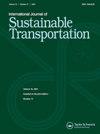Toward sustainable transportation: A systematic review of EV charging station locations
IF 3.9
3区 工程技术
Q2 ENVIRONMENTAL STUDIES
International Journal of Sustainable Transportation
Pub Date : 2025-10-03
DOI:10.1080/15568318.2025.2528085
引用次数: 0
Abstract
The increase in electric vehicles (EVs) has boosted scientific investigation about identifying suitable locations for EV charging stations (EVCSs). Yet, different methodologies and criteria often lead to differing conclusions regarding suitable EVCS locations. This raises a critical question for planners and policymakers: In the large body of scientific literature on EVCS placement, what Points of Interest (PoI) and Geographic attributes (GAs) are used to determine suitable sites for EV infrastructure deployment? This article uses a systematic literature review to dive deep into where EVCS should be placed. The review identified a pool of 28 PoIs and 11 GAs used in EVCS allocation to support the planning process. These included various shopping locations such as supermarkets, shopping malls, residential areas, power and transport infrastructure layouts, etc. Additionally, the review suggests PoIs and GAs are affected by geographical scale and context. These identified PoIs and GAs should be used as foundational insights by planners and policymakers when planning to deploy EVCSs, thereby supporting the transition to sustainable mobility.
迈向可持续交通:电动汽车充电站选址的系统回顾
电动汽车(EV)的增加推动了关于确定电动汽车充电站(evcs)合适位置的科学调查。然而,不同的方法和标准往往导致不同的结论关于合适的EVCS位置。这给规划者和决策者提出了一个关键问题:在大量关于EVCS布局的科学文献中,哪些兴趣点(PoI)和地理属性(GAs)用于确定电动汽车基础设施部署的合适地点?本文采用系统的文献综述来深入探讨EVCS的定位。审查确定了用于EVCS分配的28个poi和11个GAs,以支持规划过程。其中包括超市、商场、住宅区等各种购物场所、电力和交通基础设施布局等。此外,该审查表明,目标和气体受到地理规模和环境的影响。规划者和政策制定者在规划部署evcs时,应将这些确定的poi和GAs作为基础见解,从而支持向可持续交通的过渡。
本文章由计算机程序翻译,如有差异,请以英文原文为准。
求助全文
约1分钟内获得全文
求助全文
来源期刊
CiteScore
8.90
自引率
2.60%
发文量
56
期刊介绍:
The International Journal of Sustainable Transportation provides a discussion forum for the exchange of new and innovative ideas on sustainable transportation research in the context of environmental, economical, social, and engineering aspects, as well as current and future interactions of transportation systems and other urban subsystems. The scope includes the examination of overall sustainability of any transportation system, including its infrastructure, vehicle, operation, and maintenance; the integration of social science disciplines, engineering, and information technology with transportation; the understanding of the comparative aspects of different transportation systems from a global perspective; qualitative and quantitative transportation studies; and case studies, surveys, and expository papers in an international or local context. Equal emphasis is placed on the problems of sustainable transportation that are associated with passenger and freight transportation modes in both industrialized and non-industrialized areas. All submitted manuscripts are subject to initial evaluation by the Editors and, if found suitable for further consideration, to peer review by independent, anonymous expert reviewers. All peer review is single-blind. Submissions are made online via ScholarOne Manuscripts.

 求助内容:
求助内容: 应助结果提醒方式:
应助结果提醒方式:


